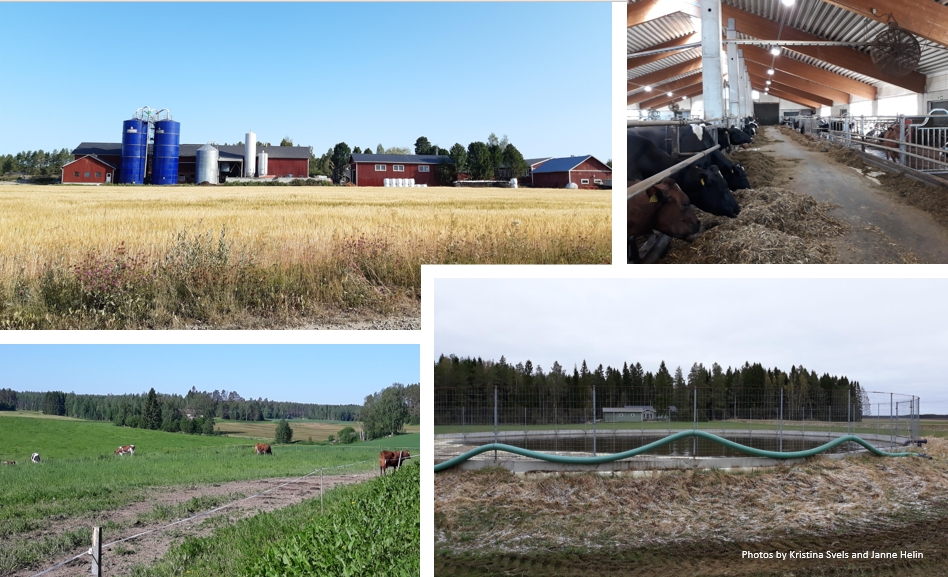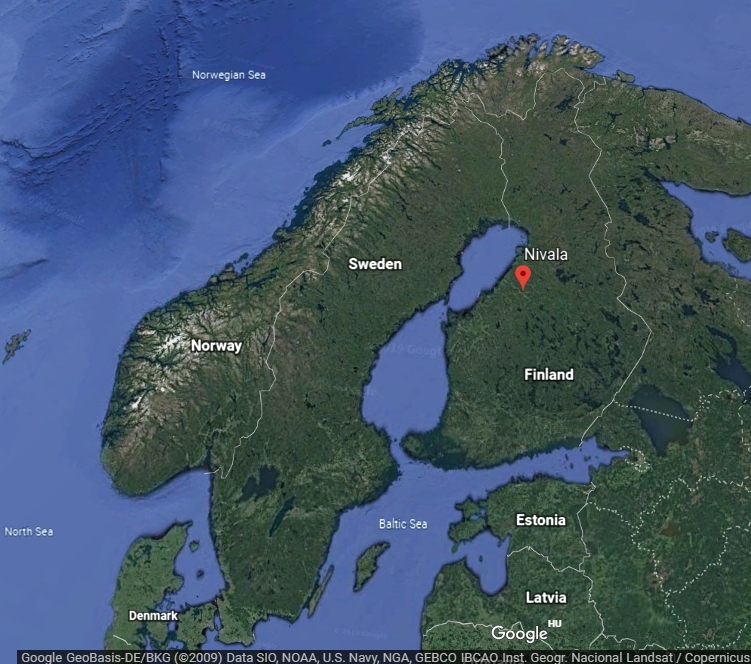Case study dilemma and research questions
How to reduce harmful climate, water and soil impacts of dairy farming in Nivala region without sacrificing economic viability of the local dairy sector, by means of envisioning and implementing a multipurpose bio-product plant along the principles of circular bioeconomy, with the aim of producing bioenergy (mainly biogas) and organic fertilizers from manure. What are incentives of the major actors to support the transition process towards more carbon neutral milk production in Nivala region? What are barriers that may prevent the bio-product plant to become realized despite of almost unanimous local consensus backing the idea?
Key characteristics and sustainability issues of the farming system
Dairy farming is the most economically, environmentally and socially important type of farming in Finland. Close to 48% of the value of agricultural production in Finland is in animal husbandry and most of it comes from the dairy farms (6 704 in 2017). The number of dairy farms in Finland is declining and the share of imported dairy products is increasing, which signals lack of competitiveness and problems for economic and social sustainability. To increase economic returns of domestic production several types of subsidies are paid to dairy farms, including investment subsidies to promote establishing larger farms, which are thus able to produce milk at lower cost. For the domestic milk market this leads to larger farms pushing smaller farms out of the business. The decline in farm numbers can lead to social problems as sparsely populated rural communities lose people and taxpayers. For environment, what might first seem as positive development in the efficiency of milk production that saves resources, has had negative consequences in the form of water and climate emissions as well as deteriorated soil quality. For water quality, the growth in unit size increases the amount of manure produced in a single farm, thus increasing the quantities of nutrients on fields that are located within economically meaningful transport distances, which in turn increases the eutrophication of surface water. For climate, the greenhouse gas emissions are greatly increased when the increase of animal numbers leads to clearing peatland soils for agriculture to produce more feed within feasible transport distance and also to cope with the limitations set in the agri-environmental policy to prevent over fertilisation in order to avoid the water pollution.
Key actors involved
Valio (the biggest dairy cooperative and milk processor in Finland), dairy farmers in Nivala, Gasum (a state owned energy company with special interest on biogas), the town of Nivala.
Agro-ecological practices and sustainability trade-offs
The two main agro-ecological practices taking place in Nivala given the installation of the biogas plant are biofertilizer and biofuel production from manure and grass silage digestate. Biofertilizer production would substitute the commercial mineral fertilizers used by the farms. This practice has the potential to reduce the adverse effect of nutrient run-off in water bodies, reduce the carbon footprint from mineral fertilizer acquisition and improve the farmer’s control on nutrient circulation. On the other hand, it can increase emissions and costs of transport and reduce the organic carbon in the soils of the dairy farms. Biofuels would substitute fossil fuel usage both in farms and by the private drivers in the area through the installation of a biomethane refueling station. The benefits of biofuels derive from carbon footprint reduction in fossil fuel substitution and the improved nutrient circulation brough by the anaerobic digestion system. To be used on farms however, machinery such as tractors and trucks would need to be upgraded to use liquified biomethane, raising the farm capital costs. Biofuel from biogas could thus reduce the dependency of farms on external sources of energy and protect from supply or price shocks that can result for example from global climate change or from various mitigation and adaptation efforts.
Key barriers of implementation agro-ecological practices
The key barrier for the development of biogas production capacity in Finland is the low return to investment. A share of the revenue in a biogas concept with digestate valosarisation depends on the current and future demand of the biofertilizer product, of which very little information exists. Furthermore, Valio’s technology for nutrient valorization has not been demonstrated in a large-scale, functioning plant, which increases the risk for various problems in production. As the return to investment from valorization requires increasing the scale of the plant to such a degree that it needs feedstock from a large number of farms, the transaction costs of managing the feedstock supply increase (consider the difference of convincing 5 farms with 50 farms in providing stable supply of feedstock and making the agreement including price). Hence, the economic risk in the investment in valorization is high compared to the expected profits.
Under some market conditions, poorer than expected performance in valorization, could be compensated by profits in production of biofuel from biogas. However, the biofuel market too, is uncertain. While biogas demand in traffic use is expected to increase ten-fold by 2035, the competition with the electric vehicles and other biofuels casts a serious question mark over the compressed biomethane market in future. Along with the advantage in the efficiency of converting energy to movement, the electric motors have advantage given by policies such as the European emission standards on the car manufacturers that still set biogas in the category of fossil instead of renewable fuels.
Both the biofertilizer and biofuel markets are very dependent on policies guiding agriculture and energy sectors. Thus, while currently the policies are favouring biogas production in very many ways, there is no guarantee that future policies will as be as biogas friendly, which means that a considerable policy risk exists in the investment decisions.
Finally, it is difficult to assess the importance of local of resistance in withdrawal of Valio from the original plant concept that received a positive investment subsidy decision in 2018 and was supposed to be located in the industrial zone near the town center and with lowest logistics costs for the transport of manure. While the municipal administration of Nivala supported the project, complaints from some of the town residents could have posed a risk in tarnishing the Valio’s milk brand, which far exceeds the additional revenues that the investment in biogas business would bring in the current business environment.
Key actions and strategies to overcome barriers
The strategy adopted in Finland is to subsidise the investment costs of biogas plants, include biogas on the list of fuels that can be used to fulfil the obligation of minimum required biobased component for fuel used in traffic, subsidise valorization of the digestate, subsidise the infrastructure for distributing biogas in the transport sector and to promote biogas use in the advisory services and research.
The stakeholders participating in the online workshop arranged by the UNISECO project in Finland were mainly satisfied with the measures set in government Biogas Programme of 2020. Policy changes supporting small-scale biogas plants that do not use valorization were given the highest priority. This outcome reflects the participant composition of the stakeholders, including representatives from that business segment besides the local actors from Nivala. The results can also be interpreted as a signal of changing priorities on the type and scale of biogas concept that is more likely to be implemented in practice in Nivala. This could indicate that due to low return to investment in valorization, the strategy is reoriented to build several small-scale plants on farms instead of a more centralized solution combining manure from several farms. However, this would mean that enhancing the nutrient circulation would play a more minor role in the future biogas solutions. By beginning of 2021, there have been no further public announcements on how the biogas project started by Valio in 2017 in Nivala would be finished.

Key lessons learnt
Some measures, such as converting manure into biogas, can gather a wide range of policies to support their implementation. A part of the success stems from creating a solution, which can be sold to a large enough group of customers with reasonable payback times for the investment. Emerging of such market prospects forms actor networks, which create lobbying power to set research priorities and to direct policies to support the emerging technology.
One step in technological transition is to get acknowledged at a national level, for example by formulation of a government programme consisting of economic incentives such as investment subsidies or taxation and by road maps, research programmes and standards. To reach such a level of political and administrative support, a series of stakeholder interactions in a variety of forms takes place. The process is rather iterative and gradual, given the Finnish biogas example, lasting for decades.
While the wide range of existing policy developments can signal of success to gather public support, it does also place a burden for developing new measures. The existing policies are affecting the potential to modify and improve the existing state of the art or to create new technologies. For example, in the Finnish case, the valorisation of the digestate enters the market defined by traditional policies for both biogas and nutrient management. It competes for funding and feedstock with biogas plant concepts that do not include biofertilizer production. To gain traction, the new technology has to demonstrate its benefits. In the Finnish case, the added environmental benefits from biofertilizer production are not easy to quantify. In the dialogue of which policies to implement and how to target them, emerging solutions that do not have as solid evidence as the more conventional options can be overlooked. The co-construction process itself can lead to new barriers for emerging technologies. For a project like UNISECO, covering a very diverse set of environmentally friendlier practises, it is difficult to tailor the decision support and data gathering to build a very thorough science base for any of the individual technologies that are still emerging.
In the Finnish case study of Nivala it is rather obvious that the existing policies on national and EU level are the key drivers of transition. While the role of research projects in co-constructing strategies maybe more important in cases in which the agro-ecological practises are less developed, it well maybe that more mature technologies are selected for EU research projects, because of the actor networks that have formed around such technologies are more established and capable of promoting further research than what is possible with technologies that are still only emerging. If, such concerns are common, it would be important to ensure that the metrics of measuring objectives, whether environmental or social, are neutral and open as well as that policies for reaching the objectives are not locking down the existing technology, but allow new solutions to compete in fair terms with the old ones.
Download
- Presentation material: Maidontuotannon ilmastovaikutuksista maailmalla ja Nivalassa - in Finish
- Summary of Nivala case study: UNISECO Finland - presentation material by David Huisman Dellago and Janne Helin at Biogas Policy Incentives Co-Construction Workshop 27.11.2020 - in English
- UNISECO H2020 policy brief: The profitability of biogas investments remains an obstacle to achieving the carbon neutrality objectives of the dairy value chain
- UNISECO H2020 policy brief: Biokaasuinvestointien kannattavuus edelleen este maitoketjun hiilineutraaliustavoitteiden toteutumiselle
Related newsitems
https://uniseco-project.eu/news/18/uniseco-1st-annual-meeting-and-stakeholder-workshop-in-helsinki
Transition process towards more carbon neutral milk production in Nivala region
